The week at a glance
- Green Heron still in Cornwall
- Solitary Sandpiper in Devon
- Common Nighthawk in Durham
- Buff-bellied Pipits in Shetland and Co Cork
- Two Hermit Thrushes on Outer Hebrides
- Pallas's Grasshopper Warblers on Shetland and in Durham
- Sykes's Warbler on Shetland
- House Crow still in Co Cork
- House Finch still in Devon
- Yellow-rumped Warblers in Co Cork and Co Galway
- Bobolink in Pembrokeshire
- Possible Eleonora's Falcon on Scilly
- Possible Olivaceous Warbler sp. in Norfolk
- Possible Hume's Leaf Warbler on Shetland
- Possible Collared Flycatcher in Co Cork
- Possible Blackpoll Warbler on Scilly
With further massive arrivals of birds along the east coast, common, scarce and rare alike, it was a great week to be out. But with all the really major Nearctic arrivals being in the Western Isles and along the east coast, it wasn't the best of October weeks to be in the southwest. One very nice exception was the first-winter Green Heron that remained in the Lost Gardens of Heligan (Cornwall) all week, at times showing down to a couple of metres!

Green Heron, Heligan, Cornwall (Photo: Bob Mitchell)
Green Heron, Heligan, Cornwall (Film: chippler01).
For those on Scilly, there weren't exactly rich pickings, but more frustration than anything else. A possible pale-morph Eleonora's Falcon was seen on St Mary's (Scilly) on 8th and on both St Mary's and St Agnes on 11th, though it evaded confirmation.
The southwest also managed a juvenile Solitary Sandpiper at Seaton Marshes (Devon) on 10th–13th, which showed well alongside several Green Sandpipers for an excellent comparison. Considering there have been three records in Cornwall, it is perhaps surprising that this is the first record for Devon.

Solitary Sandpiper, Seaton Marshes, Devon (Photo: Rob Cross)
Solitary Sandpiper, Seaton Marshes, Devon (Film: Scythebill).
In the northeast, a very obliging Common Nighthawk was seen in bushes, and on the roof of the finder's car, at Horden (Durham) on 11th. It was only seen by the original finder who realised it was something unusual, but didn't realise the enormity of the record. If it wasn't for the photographs passed to local birders this would surely have been dismissed as a Nightjar. Ignoring an Orkney bird in 1978, this is the first east-coast record of the species, though oddly there are inland records from London/Surrey (1984) and Nottinghamshire (1971).
A Buff-bellied Pipit at Braewick (Shetland) on 11th may have been the relocating Esha Ness bird, with another at Pilmore (Co Cork) on 12th.
Another Catharus in the Western Isles was a pleasant surprise, when a Hermit Thrush was found at Brevig, Barra (Outer Hebrides) on 9th, remaining until 11th. Quite incredibly, another was then found, and later ringed, at Loch Druidibeg on South Uist on 10th. With only eight accepted records, to see two in the same week so close together is unprecedented!
Following a possible Pallas's Grasshopper Warbler at Swinister near Sandwick (Shetland) on 7th–8th, there were other Shetland birds on Out Skerries on 8th and Fetlar on 9th. There was also a single-observer record from the Doctor's Garden at Whitburn (Durham) on 9th which couldn't be relocated. Another single-observer record was of an Olivaceous Warbler sp. at Well Woods (Norfolk) on 10th.
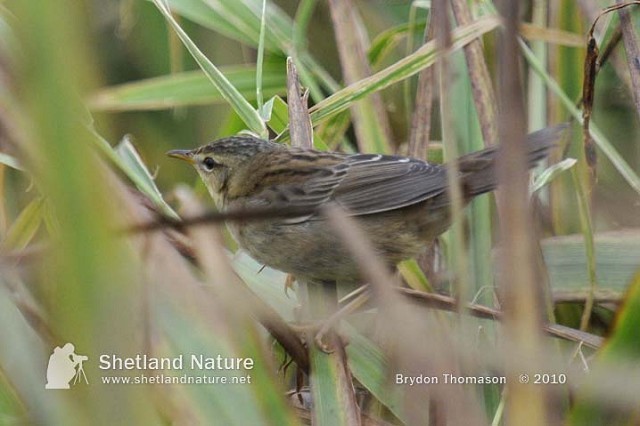
Pallas's Grasshopper Warbler, Fetlar, Shetland (Photo:
Brydon Thomason)
The Sykes's Warbler remained at Channerwick (Shetland) to 9th with another unidentified Booted/Sykes's on Out Skerries (Shetland) on 10th.
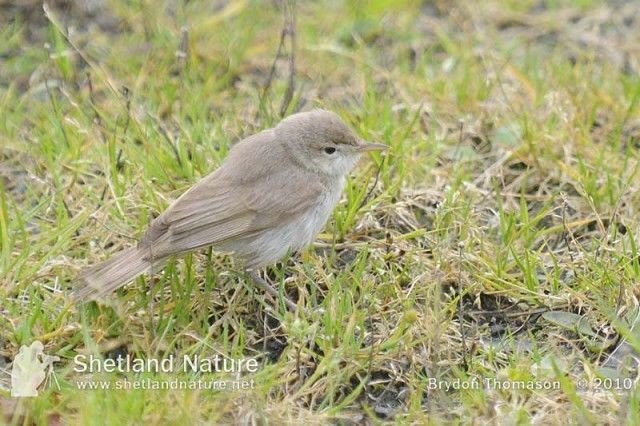
Sykes's Warbler, Tresta, Fetlar, Shetland (Photo:
Brydon Thomason)
Elsewhere the House Crow remained at Cobh (Co Cork) all week and, after a short absence, or lack of interest, the House Finch was reported again at East Prawle (Devon) on 9th.
Wales and Ireland also jumped on the Nearctic bandwagon, with the mobile first-winter Yellow-rumped Warbler remaining on Cape Clear (Co Cork) to 13th and incredibly another at Inishmore (Co Galway) on 11th.
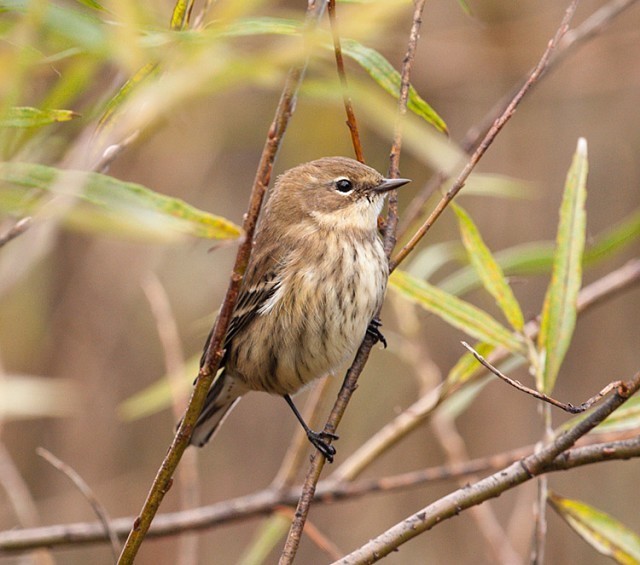
Yellow-rumped Warbler, Cape Clear, Cork (Photo: Graham Clarke)
In Wales, a Bobolink was on Skomer (Pembrokeshire) on 8th–11th, although the lack of accessible boats to the island caused some problems.
The last few 'possibles' — and we won't mention any non-mega possibles as there are too many! — included a Hume's Leaf Warbler still at Fladdabister (Shetland) on 7th, a Collared Flycatcher on Cape Clear (Co Cork) on 12th and a Blackpoll Warbler at Lower Moors, St Mary's (Scilly) on 10th.
While it was a busy month for passerines, there was still plenty of non-passerine interest. The Ross's Geese remained with Pink-feet in Montrose Basin (Angus & Dundee) to 9th and with up to 8,750 Barnacle Geese at Caerlaverock (Dumfries & Galloway) until 12th, with Ruddy Shelduck at Pickering Pasture (Cheshire) on 9th, Kedleston Park (Derbyshire) on 12th and Neumann's Flash (Cheshire) on 13th.

Ross's Goose, Caerlaverock WWT, Dumfries & Galloway (Photo: Ian Fulton)
Chew Valley Lake (Somerset) continued to hold up to three drake Ferruginous Ducks to 11th, with other drakes at Wintersett Reservoir (West Yorkshire) to 10th and Ranworth Broad (Norfolk) on 12th, with a female at Lackford Lakes (Suffolk) to 7th. The drake Ring-necked Duck at Chew Valley Lake was reported again on 11th, with others still at Kirkby on Bain Gravel Pits (Lincolnshire) to 13th and another drake at Achill Island (Co Mayo) on 8th.
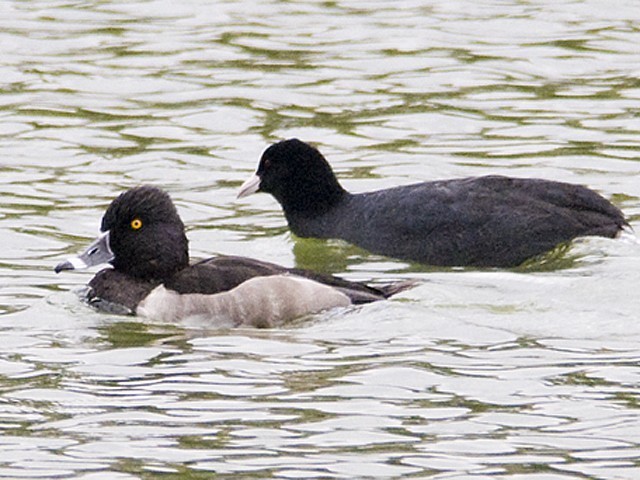
Ring-necked Duck, Kirkby on Bain GPs, Lincolnshire (Photo: Trevor Gunby)
From the west, the adult drake Black Duck was still at Achill Island (Co Mayo) on 7th–8th, juvenile Blue-winged Teal were still at Shannon Airport Lagoon (Co Clare) on 9th and Tacumshin (Co Wexford) to 13th, with another at Coonagh (Co Limerick) on 9th, and there were Lesser Scaup at Draycote Water (Warwickshire) to 13th and at Innermessan (Dumfries & Galloway) on 12th.

Lesser Scaup, Draycote Water, Warwickshire (Photo: Dave Hutton)
Drake Surf Scoters were recorded off Kincraig Point (Fife) on 9th and in Inganess Bay (Orkney) on 12th. The King Eider remained off the Suffolk coast between Minsmere and Dunwich Cliffs all week, with another eclipse drake off Burghead (Moray & Nairn) on 8th–11th. There was another drake Northern Eider, this time at Embo (Highland) on 12th.
Seabird passage was expectedly slow, with small numbers of Sooty Shearwaters reported past Lothian, East Yorkshire, Suffolk, Essex and Kent. The only double-figure count was of 47 past Dursey Island (Co Cork) on 7th. Peak counts of Balearic Shearwaters were 28 past Hengistbury Head (Dorset) on 9th and 26 past Berry Head (Devon) on 9th and Porthgwarra (Cornwall) on 7th.
The Glossy Ibis remained at Stanpit Marsh (Dorset) to 13th, with three still on the Otter estuary (Devon) to 13th. Elsewhere, singles were over the Cotswold Water Park (Gloucestershire) on 8th, Wellington Gravel Pits (Herefordshire) on 10th, Mersehead (Dumfries & Galloway) on 11th–13th, East Malling (Kent) on 11th and at Ardboe (Co Tyrone) on 11th–12th.
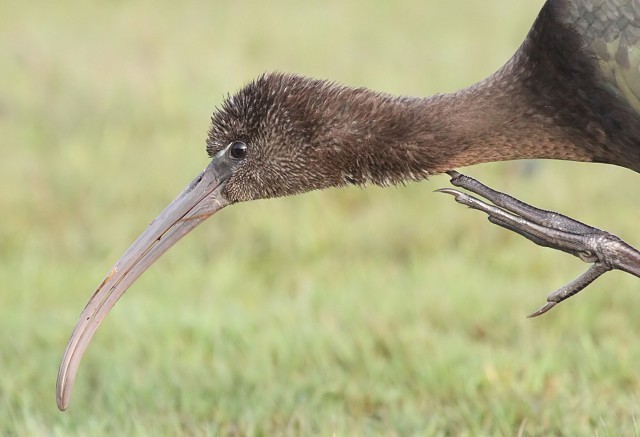
Glossy Ibis, Stanpit Marsh, Dorset (Photo: Lee Fuller)
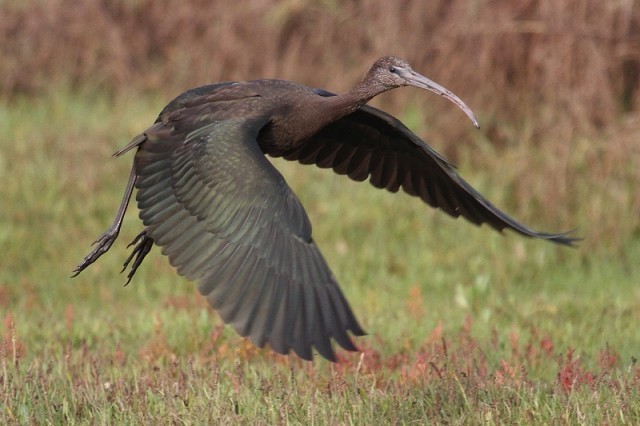
Glossy Ibis, Stanpit Marsh, Dorset (Photo: Steve Carey)
The only report of White Stork was of a group of five over Newton Abbott (Devon) on 9th, and equally interesting was a Black Stork on a roof in Dover (Kent) on 10th.
The long-staying Great White Egrets remained in Nottinghamshire, Hampshire, Shropshire and Kent, and other singles were seen in Argyll, Cumbria, Lancashire, Northamptonshire, Gloucestershire, Cambridgeshire, Norfolk, Suffolk and Kent, with two at Ham Wall (Somerset) on 7th.

Great White Egret, Blashford Lakes HWT, Hampshire (Photo: Trik)
Various Cattle Egrets were reported, although some may have just been elusive, at Donna Nook (Lincolnshire) on 10th–12th, Steart (Somerset) on 10th–13th, Shapwick Heath (Somerset) on 10th and Wivenhoe (Essex) on 12th. Of more interest was a juvenile Squacco Heron at Angle Bay (Pembrokeshire) on 10th–13th — the first record for the county.
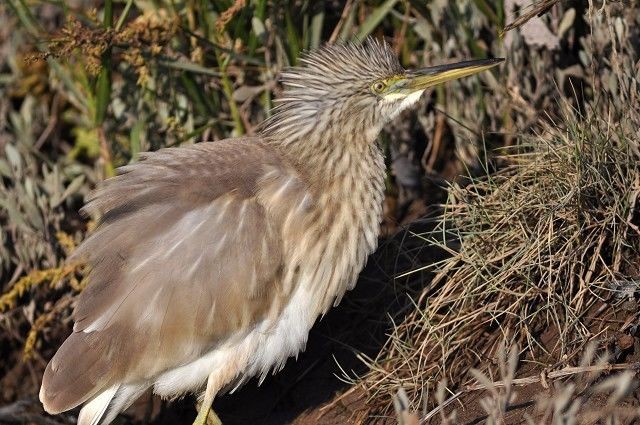
Squacco Heron, Angle Bay, Pembrokeshire (Photo: anon)
On the raptor front, Norfolk was the place to be, although nothing is ever simple. A ringtail harrier photographed over Holme NOA (Norfolk) on 11th showed a nice pale complete collar suggesting Pallid Harrier, although other features seemed to suggest this might just be a well-marked Montagu's Harrier. There was then a record of a Saker Falcon at Sculthorpe (Norfolk) on 7th, although its origins are probably rather suspect. Elsewhere, Black Kites were seen at Toe Head (Co Cork) on 9th and Tory Island (Co Donegal) on 10th.

Montagu's Harrier, Holme Dunes NWT, Norfolk (Photo: Steve)
The only Spotted Crake remaining was one at Greylake RSPB (Somerset) to 13th.
Several American Golden Plovers remained, with most in Ireland: at Shannon Harbour (Co Offaly) on 7th, Cashen Estuary (Co Kerry) to 9th, Lissagriffin (Co Cork) on 8th, Myroe Levels (Co Londonderry) on 8th, Truska (Co Galway) on 9th, moving to Aillebrack on 10th, Rosscarbery (Co Cork) on 10th and an adult at Rahasane Turlough (Co Galway) on 10th. This side of the Irish Sea were three birds, at West Gerinish, South Uist (Outer Hebrides) on 10th, on St Mary's (Scilly) again to 12th and on St Martin's on 11th.
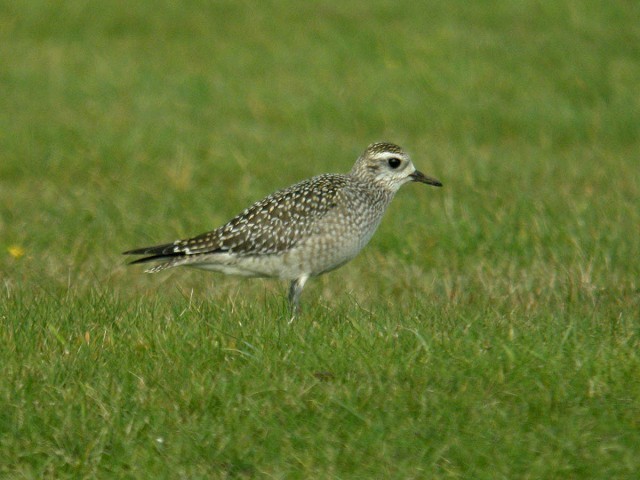
American Golden Plover, St. Mary's, Scilly (Photo: John Hague)
Equivalent numbers of Buff-breasted Sandpipers also remained, including singles at Skaw, Whalsay (Shetland) to 7th, St Mary's airfield (Scilly) to 11th, The Reef, Tiree (Argyll) to 9th and on Davidstow Airfield (Cornwall) to 12th. Two birds were at Scotney Gravel Pit (Kent) to 10th and at Esha Ness (Shetland) to 12th. In Ireland, a new bird was at Kirkistown (Co Down) on 10th–11th and two were on Dursey Island (Co Cork) on 10th–11th.

Buff-breasted Sandpiper, St. Mary's, Scilly (Photo: Stephen Allen)
Pectoral Sandpipers were reported more widely, with 25 spread across the country, including three at Loch of Strathbeg (Aberdeenshire) on 8th.

Pectoral Sandpiper, Holme Dunes NWT, Norfolk (Photo: Steve)
The Semipalmated Sandpiper remained at Abberton Reservoir (Essex) until 8th, with White-rumped Sandpipers at White's Marsh (Co Cork) on 8th, Trabeg (Co Kerry) on 13th and one at Walmsley Sanctuary (Cornwall) on 7th–9th which may have been present since 5th. A new Baird's Sandpiper was at Holland Haven Country Park (Essex) on 7th–13th and one was at Tacumshin (Co Wexford) on 10th.

Baird's Sandpiper, Holland Haven CP, Essex (Photo: John Keep)
Three Lesser Yellowlegs were in the west, at the wonderfully named Cheese Bay, North Uist (Outer Hebrides) on 9th, at Glenamaddy Turlough (Co Galway) on 9th–12th and at Tacumshin (Co Wexford) again to 11th. The Spotted Sandpiper at Turf (Devon) finally left, last seen on 10th, but was followed by a new bird at Strand Loch (Shetland) on 11th. The long-staying Long-billed Dowitcher was again at Connah's Quay (Clwyd) on 8th–9th with another at The Cunnigar (Co Waterford) on 9th–13th.

Long-billed Dowitcher, The Cunnigar, Waterford (Photo: Sean Cronin)
There were far fewer phalaropes this week, with the only Red-neckeds in East Anglia, at Cley Marshes (Norfolk) to 7th, Minsmere (Suffolk) on 8th and Buckenham Marshes (Norfolk) on 9th–10th. There were also only small numbers of Grey Phalaropes offshore, with reports from Outer Hebrides, Co Mayo, Cornwall and Guernsey, and seven past Dursey Island (Co Cork) on 7th. Inland birds were then at Burnham Overy (Norfolk) to 7th, Hornsea Mere (East Yorkshire) on 12th–13th and Sandy Water Park (Carmarthen) on 12th–13th. The only remaining Wilson's Phalaropes were at Welney (Norfolk) to 12th and Kilcoole (Co Cork) to 13th.

Grey Phalarope, Stinky Bay, Benbecula, Outer Hebrides (Photo: Steve Duffield)
The only big white-winged gulls were a Glaucous at Hornsea Mere (East Yorkshire) on 9th and Icelands at Soleburn (Dumfries & Galloway) on 8th–13th and at Cobh (Co Cork) on 9th. Also in Ireland, the American Herring Gull was again at Blennerville (Co Kerry) to at least 7th. Adult Ring-billed Gulls remained at Portrush (Co Antrim) to 12th, Westcliff-on-Sea (Essex) to 7th, with others at Doonfoot (Ayr) on 9th–10th and Dunbeg (Argyll) on 12th.

Ring-billed Gull, Dunbeg, Argyll (Photo: Bill Allan)
As with shearwaters, records of Sabine's Gull were scarce, with juveniles at Dungeness (Kent) and Exmouth (Devon) on 7th, Bardsey (Gwynedd) on 8th, from the Scillonian crossing (Cornwall) on 11th and off St Martin's (Scilly) on 13th, and an adult at Cobh (Co Cork) on 9th–12th. The only White-winged Black Tern now remaining was one at Campfield Marsh (Cumbria) on 7th, before being flushed by a Sparrowhawk.
An interesting late report was of a Pallid Swift over Low-Newton-by-the-Sea (Northumberland) for 10 minutes on 6th. Most of the Wrynecks seem to have spread south now, with the most northerly of the 33 reported being single birds in Cleveland and Durham. Of the rest, eight were in Co Cork, seven were on Scilly and four were in Cornwall.

Wryneck, St. Mary's, Scilly (Photo: John Hague)
Hoopoes were quite well represented, with birds on the Pett Levels (East Sussex) and at Cullivoe, Yell (Shetland) on 8th, Kinbuck (Forth) on 10th and South Gare (Cleveland) and Portrane Point (Co Dublin) on 11th.
There were plenty of Short-toed Larks, although most were one-day birds. One did remain at Sandaig, Tiree (Argyll) to 8th with others at Hermaness (Shetland) on 7th–9th and the Teign estuary (Devon) on 9th–10th. One-day birds were then at Sheringham (Norfolk), Fort Hommet (Guernsey), St Mary's (Scilly), Ramsgate (Kent) and Sumburgh (Shetland).

Short-toed Lark, Tiree, Argyll (Photo: Jim Dickson)
As autumn progresses, records of Richard's Pipits increase, with at least 21 during the week. Most were along the east coast from Cleveland to Suffolk, with four in East Yorkshire and three in Norfolk. There were two Tawny Pipits, at Uwchmynydd (Gwynedd) on 9th and on St Martin's (Scilly) on 11th, but six Olive-backed Pipits. These were reported at Halley Bay (Orkney) on 7th, a very popular bird at Stiffkey (Norfolk) on 9th–10th, at Brevig, Barra (Outer Hebrides) on 9th, Quendale (Shetland) on 9th–13th, Fair Isle on 10th–12th and St Mary's (Scilly) on 13th.
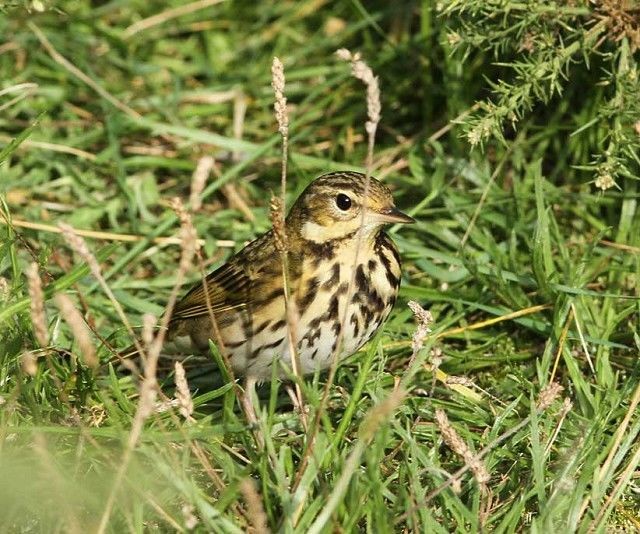
Olive-backed Pipit, Stiffkey, Norfolk (Photo: Penny Clarke)
Even more frequently reported, though perhaps less likely to be accepted by records committees, were various Red-throated Pipits. Records came from North Gare (Cleveland), Prawle Point (Devon), Holland Haven Country Park (Essex), Pendeen (Cornwall), St Mary's (Scilly), Dursey Island (Co Cork), Cape Clear (Co Cork) and Loop Head (Co Clare).
The only Citrine Wagtails were on Shetland, with birds at Sandwick again on 8th, one remaining on Out Skerries to 10th and another at Lerwick on 10th.

Citrine Wagtail, Out Skerries, Shetland (Photo: Jason Atkinson)
Once an absolute mega in its own right — anyone remember the rush for the Winspit bird? — Red-flanked Bluetails are now standard autumn fare along the east coast. This week was no exception, with no fewer than 12 records! It seems a shame not to list them, so here goes: Shetland birds were at Geosetter on 8th, Westerfield on 8th, with other Scottish birds at Queenamidda (Orkney) on 11th and Scoughall (Lothian) on 11th. In the northeast, birds were at Newbiggin-by-the-Sea (Northumberland) on 9th, St Mary's Wetland (Northumberland) on 9th–13th and Saltburn (Cleveland) on 9th–10th. Norfolk hosted an incredible four: at Wells-next-the-Sea on 9th, Burnham Overy on 11th, one ringed at Weybourne on 11th and one at Waxham on 12th–13th. Most notable, though, was the second record for Ireland, on Cape Clear (Co Cork) on 12th — the first was a ringed bird (of unknown origin) on Dursey Island (Co Cork) in November 2009.

Red-flanked Bluetail, Waxham, Norfolk (Photo: Kevin Du Rose)
A sign of the times was the fact that bluetails easily outnumbered Bluethroats, with the only birds being two on Fair Isle (Shetland) to 8th and singles at Kilnsea (East Yorkshire) on 8th and Noss (Shetland) on 9th.
October is always a good time for scarce wheatears, and this week provided a nice variety. Perhaps the most notable was the Isabelline Wheatear at Gunton (Suffolk) on 10th–11th, the fourth for the county. Black-eared Wheatears were then on St Mary's (Scilly) on 9th–13th, with a less obliging bird at Donna Nook (Lincolnshire) on 12th. Also on St Mary's was a first-winter male Pied Wheatear on 12th, with a male on North Ronaldsay (Orkney) on 10th–13th causing some initial head-scratching.
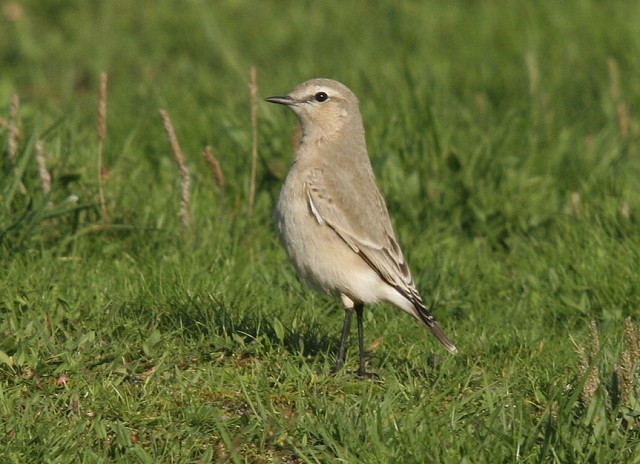
Isabelline Wheatear, Lowestoft, Suffolk (Photo: anon)
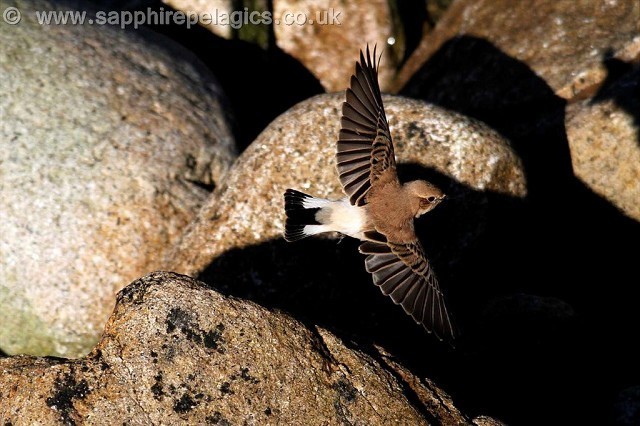
Black-eared Wheatear, St. Mary's, Scilly (Photo: Joe Pender)
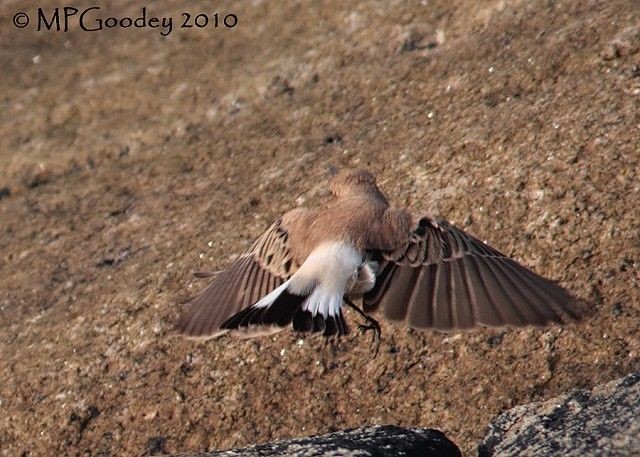
Black-eared Wheatear, St. Mary's, Scilly (Photo: Martin Goodey)

Pied Wheatear, North Ronaldsay, Orkney (Photo: Paul A Brown)
September is normally the peak month for arrivals of Robin and Song Thrush, but the main arrival seemed to be this week along the east coast. A flavour of the migrants involved comes from Holme Bird Observatory (Norfolk), where standard counts on 10th produced 4,500 Robins, 2,500 Song Thrushes, 6,500 Redwings, 250 Chiffchaffs, 7,000 Goldcrests, an impressive 300 Long-tailed Tits, 11 Jays, 1,500 Chaffinches, 800 Bramblings, 600 Greenfinches and 1,100 Siskins.
The 10th produced two Black-throated Thrushes, with one at Scalloway (Shetland) and another claimed at Warham Greens (Norfolk), though the latter came with no confirmation.
The first Subalpine Warbler of the autumn was a first-winter on Bryher (Scilly) on 12th–13th, and also on the islands were an out-of-place Cetti's Warbler ringed on St Mary's and a Dartford Warbler on St Martin's on 13th. Barred Warblers were primarily still in the north and west, with 22 birds reported. Of these, 10 were in Scotland, including five on Shetland, with the furthest south being two in Norfolk, at Kelling and Holme and two in Kent, at Sandwich and Reculver.
The Lanceolated Warbler remained at Skaw, Unst (Shetland) to 7th with another on Out Skerries (Shetland) on 9th. The same site held a Blyth's Reed Warbler on 9th, with other Shetland birds at Aith (Fetlar) to 7th and on Fair Isle on 11th.
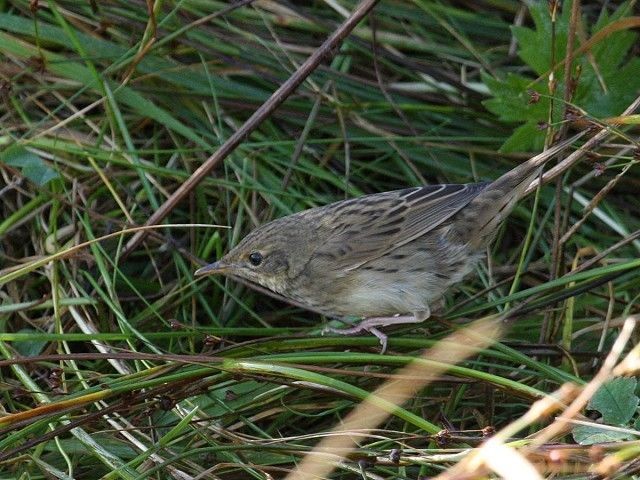
Lanceolated Warbler, Skaw, Unst, Shetland (Photo: John Hague)
The only Paddyfield Warbler was at Loop Head (Co Clare) on 10th–11th. This is the first for the county and only the fifth for Ireland.

Paddyfield Warbler, Loop Head, Clare (Photo:
James Hayes)
Most of September's Hippos moved through, with Icterine Warblers at Scarborough (North Yorkshire) on 8th–11th, Norwick, Unst (Shetland) on 9th and two on Bryher (Scilly) over 10th–12th. One on St Martin's on 12th–13th was eventually reidentified from photographs as a Melodious Warbler.
The only Western Bonelli's Warbler reported was at Lerwick (Shetland) on 11th–13th, though there were big numbers of other Phylloscs. Yellow-browed Warblers were seemingly everywhere, with birds along most coasts. Peak counts were of 12 on Fair Isle (Shetland) on 11th, four on North Ronaldsay (Orkney) on 9th and three on Cape Clear (Co Cork) and in Kenidjack valley (Cornwall). Inland, one was ringed at Stanford Reservoir (Northamptonshire) on 7th, with others at Burnley (Lancashire) on 11th–13th and Belvide Reservoir (Staffordshire) on 12th.
The first definite Pallas's Warbler of the year was at Skaw, Unst (Shetland) on 7th and was followed by one on the Farne Islands (Northumberland) and two on Shetland on 8th, with three new birds on Shetland and another at Filey (North Yorkshire) the next day. The rest of the week saw one at Torness (Lothian), two in East Yorkshire, two in Lincolnshire, three in Norfolk and further south birds at Kessingland (Suffolk), Pegwell Bay (Kent) and one on St Mary's (Scilly).

Pallas's Warbler, Burnham Overy, Norfolk (Photo: Yvonne)
There were good numbers of Radde's Warblers, with Norfolk again doing well, with birds at Great Yarmouth cemetery and Warham Greens on 9th. Shetland also held two, at Whalsay on 8th and at Sandwick on 11th–12th. Others were at Filey (North Yorkshire) on 9th–10th, Kineff (Aberdeenshire) on 9th, Craster (Northumberland) on 10th and one was ringed at Kilnsea (East Yorkshire) on 10th.
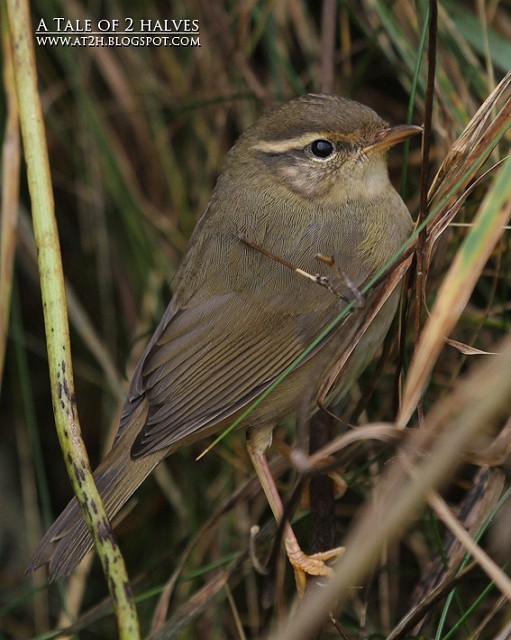
Radde's Warbler, Skaw, Whalsay, Shetland (Photo: Jason Atkinson)
Dusky Warblers were also well reported, mostly in the north. There were three in Shetland, at Quendale and on Unst and Fetlar, three in Northumberland, at Tynemouth, Beadnell Bay and Howick, with others at Hartlepool Headland (Cleveland) and Scarborough (North Yorkshire). The only southern bird was at Margate (Kent) on 9th.

Dusky Warbler, Scarborough, North Yorkshire (Photo: Dave Mansell)
The mass arrival of Red-breasted Flycatchers continued, with large numbers of new birds still being found. At least 35 were reported this week, with most on Scilly (seven birds) and Shetland (four birds), though an inland bird at Northallerton (North Yorkshire) was also notable.
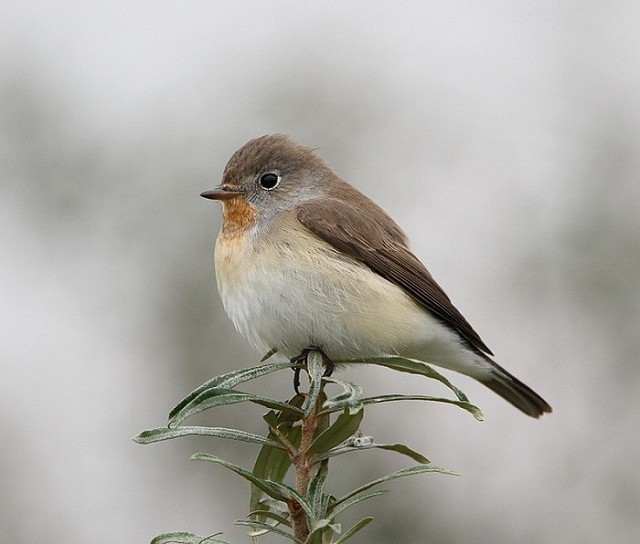
Red-breasted Flycatcher, Donna Nook, Lincolnshire (Photo: Dean Eades)
A few juvenile Penduline Tits started appearing, perhaps for the winter, with birds at Pegwell Bay (Kent) on 9th, briefly at Dawlish Warren (Devon) on 11th and two at Titchfield Haven (Hampshire) on 12th.
The large numbers of Great Grey Shrikes arriving last week continued, and at least 59 birds were reported from primarily northern and eastern sites. Top county was Norfolk, with eight birds, with five in both East Yorkshire and Lincolnshire and four in Cleveland and Kent. Notable southern or inland birds were at Llangorse Lake (Powys), the Lizard (Cornwall) and Wormwood Scrubs and Enfield (London).

Great Grey Shrike, South Gare, Cleveland (Photo: Mick Brennan)
Red-backed Shrikes were far less numerous, with just 10 birds reported: two in Cornwall and Lancashire and singles at Evie (Orkney), Longhaven (Aberdeenshire), Kincraig Point (Fife), South Gare (Cleveland), Cape Clear (Co Cork) and North Cotes (Lincolnshire). The Woodchat Shrike remained at Hartlepool Headland (Cleveland) to 12th and Isabelline Shrikes were at Gibraltar Point (Lincolnshire) on 10th and Scousburgh (Shetland) on 12th–13th.
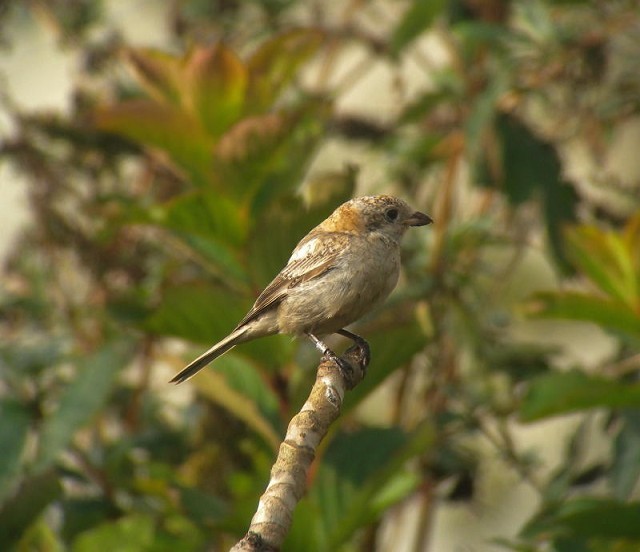
Woodchat Shrike, Hartlepool Headland, Cleveland (Photo: Mr Lawton)
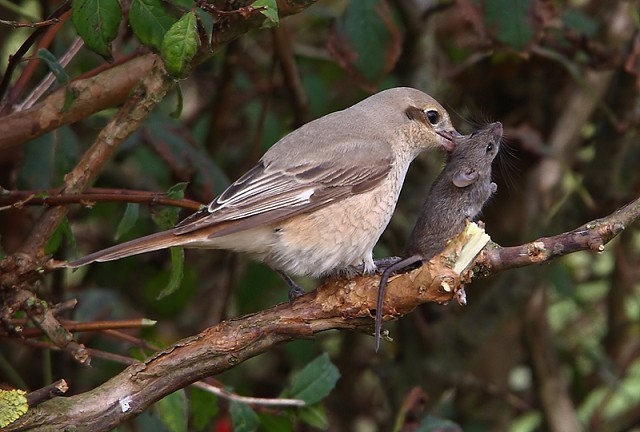
Isabelline Shrike, Scousburgh, Mainland, Shetland (Photo: James Wood)
Juvenile Rose-coloured Starlings included birds at Ballinacarriga (Co Cork), North Ronaldsay (Orkney) and one that continued to roost in Penzance (Cornwall) to 11th. This or another was then seen in Kenidjack Valley (Cornwall) on 11th, at Pendeen on 12th and at Porthgwarra on 13th. The only adult was at Newhaven (East Sussex) on 11th–13th.
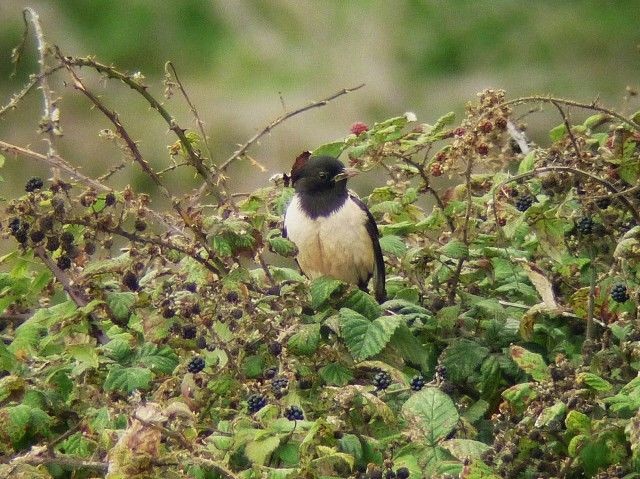
Rose-coloured Starling, Newhaven, East Sussex (Photo: Mickd)
There were fewer records of hornemanni Arctic Redpolls, with Shetland birds at Baltasound, Unst on 11th and on Fair Isle on 12th–13th, with one on South Ronaldsay (Orkney) on 8th. Interestingly, there was then an exilipes, or Coues's, race bird at Baltasound, Unst on 13th.
With reasonable observer coverage, at least three Common Rosefinches were reported on the Isles of Scilly, beaten by the four on Shetland, on Out Skerries and at Sandness, Quendale and Wester Quarff. Two were on the Outer Hebrides, on Lewis and Barra, with other birds at Annagh Head (Co Mayo), two on Three Castles Head (Co Cork) and one at Trumpan, Skye (Highland).
Black-headed Buntings were at the extremes, with one on St Agnes (Scilly) on 7th and the one on Out Skerries (Shetland) joined by a second on 8th. Ireland didn't miss out, with its fifth record of Yellow-breasted Bunting, on Dursey Island (Co Cork) on 9th. All the previous records have been on islands, with two on Cape Clear (Co Cork) and two on Tory Island (Co Donegal).
More late-autumn fare were the various Little Buntings this week. Surprisingly the only Shetland bird was one at Norwick, Unst again on 7th, with others on the Isle of May (Fife) on 9th, at Pegwell Bay (Kent) on 10th, at Easington (East Yorkshire) on 10th and a probable reported at Snettisham (Norfolk) on 10th. There were also two at Spurn (East Yorkshire) on 9th–11th and up to three at Carn Friars, St Mary's (Scilly) on 7th–10th.

Little Bunting, St. Mary's, Scilly (Photo: John Hague)
Most of the autumn's Ortolan Buntings seem to have moved on, with three remaining on Shetland, on Foula on 9th, Sandness on 10th and Melby on 11th. The only others were at Landguard (Suffolk) on 13th and the unusual location of Brent Reservoir (London) on 12th. There were still plenty of Lapland Buntings around the country, but mostly now in small, well spread groups. The only notable counts came from the northwest, with 150 at Howmore, South Uist (Outer Hebrides) on 7th, 100 at Borgh, Benbecula (Outer Hebrides) on 12th, 70 at Loch Paible, North Uist (Outer Hebrides) on 11th and, further south, 80 at Northcoates Point (Lincolnshire) on 9th. Early in the week Rustic Buntings put in an appearance at Kilnsea (East Yorkshire) on 8th–9th, Sanday (Orkney) on 8th and at Coatham Marsh (Cleveland) on 9th.
Last, but certainly not least, the Red-eyed Vireo remained at Firkeel Glen (Co Cork) until 12th, with another at North Locheynort, South Uist (Outer Hebrides) on 10th. Quite remarkably, this was then joined by another on 11th–12th. The east coast also scored, with one ringed at Seaton Carew (Cleveland) on 11th.
Photo of the Week: 7th—13th October
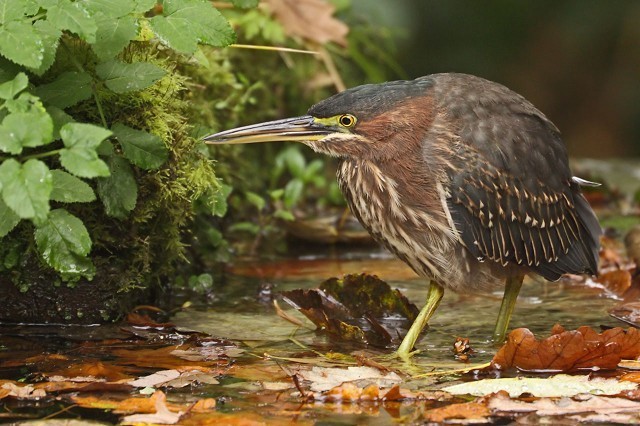
Green Heron, Heligan, Cornwall (Photo:
Stephen Burch)
Oxfordshire-based bird photographer Stephen Burch certainly gets around with his camera and, spending some time in Cornwall recently, was well placed to catch up with the first-winter Green Heron that dropped into the Lost Gardens of Heligan. Competing amidst the 'scrum' of people eager to get their own views and photos, Stephen managed to capture a top-notch environmental portrait of this great-looking American vagrant. Getting down to the heron's eye level and composing the shot with the bird walking into the frame creates intimacy, whilst the inclusion of the shallow pool and vegetated banking transports you right into the everyday world of this aquatic species. Many bird photographers are only content if they can isolate their subjects from their backgrounds, but Stephen's shot shows that the right setting can add greatly to the natural feel of the image.
Other notable photos

Great Spotted Woodpecker, undisclosed site, Worcestershire (Photo:
John Caswell)

Curlew, Italy (Photo:
Paolo Caretta)

Goldcrest, Minsmere RSPB, Suffolk (Photo:
Jon Evans)
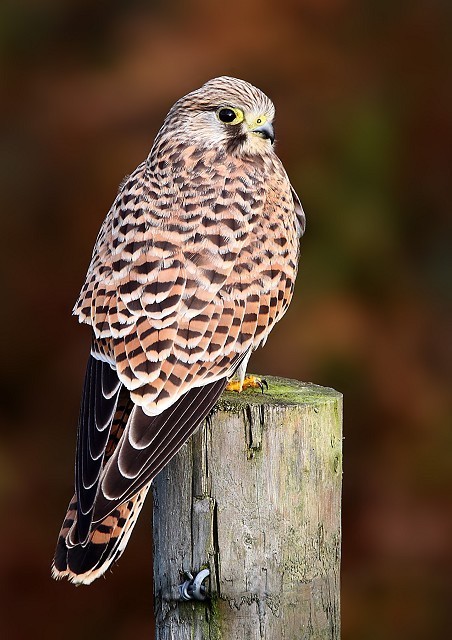
Common Kestrel, Long Mynd, Shropshire (Photo:
John Fielding)

Greylag Goose, Snettisham RSPB, Norfolk (Photo:
David Whistlecraft)

Common Kingfisher, Far Ings NR, Lincolnshire (Photo:
Graham Munton)

Gannet, Moray Firth, Moray & Nairn (Photo:
Sandra Standbridge)

Comb Duck, India (Photo:
Mital Patel)

Marsh Harrier, St. Saviour's Reservoir, Guernsey (Photo:
Steve Levrier)

Northern Wheatear, North Wirral, Cheshire (Photo:
David Cookson)

Little Stint, Donna Nook, Lincolnshire (Photo:
Dean Eades)

Black Redstart, France (Photo:
John Barlow)

White Stork, Portugal (Photo:
Gordon Speirs)

Bank Myna, India (Photo:
Jaysukh Parekh Suman)

Crested Lark, Libya (Photo:
Richard Jones)

Snow Bunting, Northam Burrows CP, Devon (Photo:
Roy Churchill)

Long-billed Dowitcher, The Cunnigar, Waterford (Photo:
Ronan McLaughlin)

Gadwall, undisclosed site, Lancashire (Photo:
Tom Charles)

Dunlin, Salthouse, Norfolk (Photo:
Matt Latham)

Peregrine Falcon, Worcester, Worcestershire (Photo:
Dave Grubb)

